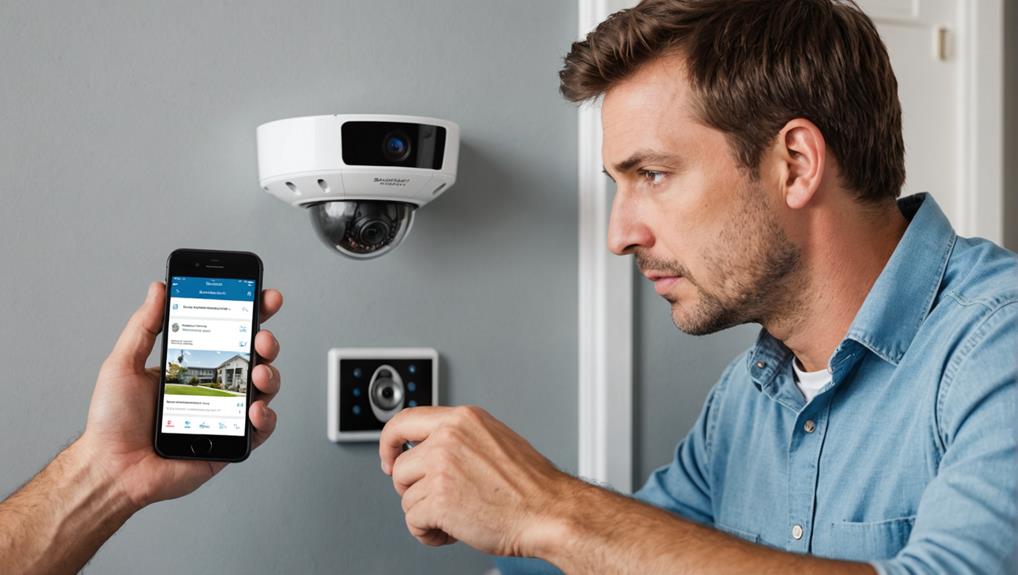When deciding on DIY or professional security system installation, consider the time, costs, and level of support needed. DIY setups can save on upfront costs and be installed in 30 minutes to 2 hours, appealing to those tech-savvy and seeking quick solutions. However, professional installations guarantee proper placement, thorough testing, and ongoing support, offering peace of mind with extensive monitoring services. Your choice may depend on balancing cost-effectiveness, convenience, and the desire for expert guidance.
Key Takeaways
- DIY installation saves on fees, offers flexibility.
- Professional installation ensures optimal system functionality.
- DIY setups provide quick installation, ideal for tech-savvy users.
- Professional monitoring offers immediate emergency response.
- Long-term costs for updates and repairs should be considered.
Installation Process Comparison

When considering the installation process for security systems, it's crucial to weigh the differences between DIY and professional setups.
DIY installations typically take between 30 minutes to 2 hours, involving unboxing, hub setup, sensor pairing, and testing. Most DIY systems are wireless, making them user-friendly. DIY systems often include peel-and-stick command strips for mounting, although brackets are recommended for durability. Additionally, DIY systems can often be more cost-effective since you avoid installation fees.
On the other hand, professional installations are carried out by technicians, requiring a scheduling commitment and starting fees around $100. Installation times for professional setups range from 2 to 4 hours, depending on system complexity. Professionals guarantee ideal sensor placement and setup, conducting thorough post-installation tests for system functionality.
DIY setups may lack the extensive testing done by professionals, leaving users responsible for checking their installations. DIY installations offer flexibility in timing and sensor placement, while professional installations may involve fixed scheduling and pre-defined equipment arrangements.
Cost Breakdown and Savings

When comparing DIY and professional security system installations, it's essential to evaluate the cost breakdown and potential savings.
DIY systems generally boast lower upfront costs and eliminate installation fees, which can result in significant savings.
However, it's important to analyze the long-term expenses, as professional systems may offer more thorough monitoring services that could justify the higher initial investment.
Cost Efficiency Analysis
For a thorough outlook on the cost efficiency of DIY versus professional security system installation, it's essential to explore the breakdown of expenses and potential savings associated with each option.
DIY security systems typically have lower upfront costs, ranging from $200 to $500 for starter packages, while professional systems can start at $200 and go up to $1,000, including installation fees.
Professional installation fees usually begin at around $100, averaging $200 for larger kits, but DIY systems eliminate these costs entirely, providing additional savings.
Monthly monitoring fees for professional systems can range from $20 to $60, whereas DIY systems often allow for self-monitoring at no ongoing cost, greatly reducing long-term expenses.
By choosing DIY over professional installation, you can save hundreds of dollars, considering the absence of installation and monitoring fees.
While professional systems may offer higher-quality equipment and support, DIY systems provide long-term savings potential through customization and the ability to add equipment over time.
Long-Term Savings Comparison
Saving money over the long term with your home security system isn't just about the initial costs but also the ongoing expenses.
When comparing DIY systems to professional installations, DIY systems can save you hundreds of dollars in installation fees, ranging from $0 to $200, while professional installations typically start at $100 and can go up to $1,000.
Additionally, DIY systems often allow for self-monitoring with no monthly fees, unlike professional systems that can cost between $20 to $60 per month for monitoring services.
With a budget-friendly approach, DIY systems offer starter packages ranging from $200 to $500, whereas professionally installed systems may require an initial investment of around $600 for basic kits.
Long-term savings are further emphasized as DIY systems provide flexibility without long-term contracts, allowing you to adjust your setup as needed without being tied down to monthly fees.
Furthermore, DIY systems enable you to save on maintenance and upgrades by giving you the freedom to add or replace components without extra service charges.
Monitoring and Support Options

When considering monitoring and support options for your security system, it's essential to weigh the benefits of professional services versus DIY solutions.
Professional monitoring services offer rapid response capabilities and dedicated support teams, ensuring immediate assistance during emergencies.
Additionally, advanced features like smart camera detection and emergency relay services are more commonly found in professional setups, enhancing the overall security of your system.
These services also often include regular maintenance and updates, ensuring your system remains up-to-date with the latest security technologies.
Monitoring Services Overview
Amidst the domain of security system installations, the scope of monitoring services stands as a significant consideration. When comparing DIY and professional options, monitoring plays an essential role in ensuring the safety of your home or business.
Professional monitoring services offer round-the-clock oversight, providing immediate responses to emergencies and dedicated support teams for troubleshooting. While DIY systems may provide self-monitoring capabilities through smartphone apps, they might lack the swift professional assistance needed in critical situations.
Professional monitoring plans usually come with monthly fees ranging from $20 to $60, whereas DIY systems can often be monitored without ongoing costs. Additionally, professional systems typically offer more thorough monitoring features, such as emergency relay services for quicker dispatch in urgent scenarios.
When choosing a security system, consider the level of monitoring and support you require. Professional services provide enhanced peace of mind with 24/7 surveillance and swift emergency responses, while DIY options offer more control and potential cost savings.
Support Features Analysis
Considering the critical aspect of monitoring and support options in security system installations, it becomes imperative to evaluate the features provided by both DIY security systems and professional monitoring services.
DIY systems typically offer self-monitoring through smartphone alerts, while professional services guarantee 24/7 surveillance with rapid emergency response capabilities. DIY systems may lack immediate emergency assistance compared to professional services that can swiftly dispatch help.
Customizable alerts are common in DIY systems, whereas professional services often include emergency relay to local authorities. Customer support for DIY systems may be limited to online resources, while professional services offer dedicated support teams for troubleshooting.
Warranty coverage also varies, with some professional services like Brinks Home providing a generous two-year warranty on equipment, offering more reassurance than many DIY systems.
When considering support features, weigh the level of monitoring needed and the importance of swift emergency response in your security system decision-making process.
Safety Measures Consideration
As you navigate the domain of security system installations, the focus now shifts to examining the critical aspect of safety measures, specifically regarding monitoring and support options.
DIY security systems often rely on self-monitoring through smartphone apps, which may lack immediate emergency response capabilities compared to professional monitoring services.
Professional monitoring services typically provide 24/7 support, ensuring rapid response to emergencies and quicker dispatch of authorities when needed.
While professional systems come with monthly monitoring fees ranging from $20 to $60, DIY systems can offer self-monitoring options with no ongoing fees.
Some DIY systems even allow for optional professional monitoring as an add-on, giving users flexibility.
Additionally, many professional security providers include extensive customer support and troubleshooting assistance, which can be advantageous for users unfamiliar with technology.
When considering safety measures, weighing the benefits of professional monitoring and support against the cost can help you make an informed decision to protect your home and loved ones.
Activation Fees and Contracts

Activation fees and contracts play an essential role in the decision-making process when choosing between DIY and professional security system installations. Activation fees for home security systems typically range from $50 to $100, but some wireless systems may waive these fees through promotions.
Additionally, initial setup costs can vary considerably based on equipment and installation needs. Monthly fees are common in professional monitoring services, with costs starting around $20 for DIY systems and up to $60 for professional systems like ADT and Frontpoint.
DIY systems often offer self-monitoring options without long-term contracts, providing flexibility and cost savings for consumers. However, hidden costs may arise from activation fees and subscription requirements in the fine print of contracts, emphasizing the importance of reviewing terms before installation.
Newer models sometimes come with built-in monitoring features, eliminating the need for activation fees. Consider your budget and preferences when deciding between the two installation options to guarantee you select the best fit for your home security needs.
Market Trends and Insights

With the electronic security installation industry in the U.S. projected to continue growing, reaching a market size of $78.9 billion by 2024, consumer interest in both DIY and professional solutions is on the rise.
Market trends indicate that DIY home security systems are expected to see a significant annual growth of 20% through 2025. This surge is primarily fueled by consumer preferences for cost-effective and customizable security options in light of the increasing rate of home burglaries, affecting approximately 1 in 36 households annually.
The convenience of setting up these systems at one's own pace and the availability of pros and cons for each type of security solution additionally contribute to the popularity of DIY options.
The average cost of professional security system installation, ranging from $200 to $1,000, plays an essential role in consumer decision-making, often influenced by budget constraints.
Moreover, user preferences vary, with tech-savvy individuals favoring the flexibility of DIY solutions, while others opt for the reliability of professional monitoring services.
Understanding these market insights can help you make an informed choice between DIY and professional security system installation to safeguard your home effectively.
Customization and Features Overview

Entering into the domain of customization and features, the world of DIY versus professional security system installations unfolds a spectrum of choices that cater to varying security needs and preferences.
DIY security systems stand out for their extensive customization options, allowing users to personalize their setups with cameras, sensors, and alarms tailored to their individual requirements. Additionally, DIY systems often come with easy-to-follow instructions, making installation accessible for most homeowners.
In contrast, professional systems typically offer pre-established packages with limited customization, focusing on all-encompassing security solutions that may not allow users to select specific components.
One advantage of DIY systems is the ability to expand gradually, enabling users to incorporate new devices and features as their needs evolve. Brands like Ring and SimpliSafe emphasize user-friendly interfaces that make integrating smart home devices seamless, enhancing overall functionality and convenience.
On the other hand, professional systems often provide advanced features like emergency response and system maintenance as part of their monitoring services but at a higher ongoing cost.
Third-Party Installation Platforms

Amidst the landscape of home security system installations, third-party platforms like TaskRabbit, Thumbtack, HomeAdvisor, Angie's List, and Yelp serve as conduits connecting users with professional assistance for setting up their security systems.
TaskRabbit stands out by offering background-checked handymen in various locations, ensuring users receive vetted help for their DIY setups. On the other hand, Thumbtack allows contractors to bid on installation jobs without conducting background checks, necessitating caution from users when selecting professionals.
HomeAdvisor provides an added layer of security by performing background checks on contractors, offering reliability for users seeking assistance with their home security installations. Angie's List gives users access to contractors with background checks, though they may face numerous follow-up calls from contractors seeking job opportunities.
Yelp allows users to request quotes from local service providers but lacks background check services, emphasizing the importance of users vetting potential installers independently before proceeding.
For homeowners keen on a DIY Security System Installation, these platforms can offer valuable options for professional assistance.
DIY vs. Professional Installation Pros

Steering through the domain of home security systems, it becomes essential to weigh the advantages and drawbacks of DIY installation against the benefits of professional setup.
DIY security systems offer cost savings by eliminating installation fees, allowing for customization, and quick setup within 30 minutes to 2 hours. Additionally, the flexibility of potential challenges and ease of installation make DIY systems appealing to tech-savvy homeowners. However, DIY installations may lead to human errors like improper sensor placement.
On the other hand, professional installation guarantees peak system functionality with trained technicians handling complex setups and providing ongoing support. Although it comes with installation fees averaging $100 to $200, professional setups offer all-encompassing monitoring services, including 24/7 emergency response capabilities.
This all-encompassing support provides peace of mind that DIY systems may lack. Ultimately, the choice between DIY and professional installation depends on your preference for cost savings and customization or the assurance of expert setup and monitoring services.
Security Brand Installation Costs

When taking into account security brand installation costs, you'll find that different companies offer various pricing structures for setting up their systems.
Beyond the initial fees, it's vital to factor in ongoing costs such as equipment updates and repairs, which can add up over time.
SimpliSafe starts at $125 for installation, while ADT averages around $150, depending on the kit size.
Vivint bundles its installation fees, with costs beginning at $100 for starter packages.
Ring Alarm provides a DIY installation option, with professional installation by OnTech starting at $130.
On average, professional installation costs around $200, especially for larger security kits.
The fees can vary greatly based on the security brand and system complexity, with some companies occasionally offering free installation promotions.
Whether you opt for professionally installed systems or DIY options, it's important to evaluate both the upfront costs and long-term benefits to guarantee your home security needs are met efficiently.
Frequently Asked Questions
Is It Better to Install Your Own Security System?
Installing your security system yourself can offer flexibility and cost savings, but it also comes with potential risks.
Consider your comfort with technology and willingness to troubleshoot issues.
Professional installation guarantees optimized setup, ideal for those with limited technical skills or time constraints.
Evaluate the trade-offs between convenience and peace of mind to determine if DIY or professional installation is the better choice for you.
Are DIY Home Security Systems Good?
DIY home security systems offer affordability, flexibility, and customization options that cater to your specific needs.
With easy installation under three hours, wireless technology, and self-monitoring features like smartphone alerts, you get control over your security without monthly fees.
Enjoy peace of mind with tailored security kits and the ability to adjust components as needed.
DIY systems are a reliable and cost-effective solution for your home security needs.
What Is the Difference Between ADT and DIY?
When comparing ADT to DIY security systems, ADT offers professional installation, 24/7 monitoring, and pre-established packages with limited customization.
DIY systems, on the other hand, allow self-installation, self-monitoring, and more flexibility in customizing security kits.
ADT involves upfront fees and long-term contracts, while DIY systems have lower initial costs and contract-free monitoring plans.
Consider your needs for ideal protection and convenience when choosing between ADT and DIY options.
How Much Does a DIY Security System Cost?
Setting up a DIY security system can range from $200 to $500 for a starter package, excluding monitoring fees.
Installation fees are often avoided, saving you around $100 compared to professional setups.
Activation fees typically fall between $50 to $100, sometimes waived during promotions.
Self-monitoring is cost-effective, skipping monthly subscription fees starting at $20.
Keep in consideration possible hidden costs for extra equipment or software updates beyond the initial purchase.
Conclusion
To summarize, choosing between DIY and professional security system installation ultimately depends on your budget, technical skills, and time availability. While DIY may save you money upfront and give you more control over the installation process, professional installation offers peace of mind, expertise, and potentially better long-term support. Consider your specific needs and preferences before making a decision to guarantee your home security system is installed effectively and provides the protection you desire.









